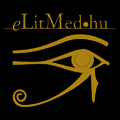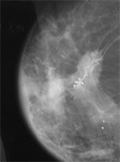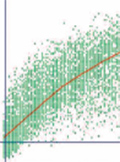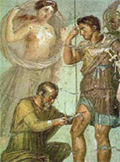The eLitMed.hu medical portal uses computer cookies for convenient operation. Detailed information can be found in the Cookie-policy.
Lege Artis Medicinae - 2016;26(04)
Content
[Treatment and care of patients with hypertension based on the new professional guidelines]
[The 10th professional guideline for treating patients with hypertension written by the Hungarian Society of Hypertension has been released now after thirty years of the first treatment proposition. This summary presents the changing which came to being since then in the risk assessment, the activity in diagnostics and the therapeutic principles, also explaining their significance. Highlighted between the topics are the therapy based on risk assessment, the changing of the target blood pressure, the alteration of therapeutic principles and the combination therapy coming to the front. The birth of new therapeutic frames and their manual interpretation are also important subjects touched upon. The professional guideline’s necessity, value and applicability to practice are also considered and evaluated.]
[What does the „whole”-ness of patients with diabetes mellitus mean?]
[Diabetes mellitus is a chronic, progressive disease, characterized by elevated levels of blood glucose, can lead to many complications and can increase the overall risk of early disability and dying prematurely. The newest guidelines on management of patients with diabetes mellitus give a full description of diagnostic criteria, prevention, lifestyle and pharmacological treatment, complications, age-related characteristics. However, in everyday care of patients with diabetes mellitus little attention is paid to severity of anatomical and functional impairment related to disease, how and in what extent those limit everyday activities, restricts filling the social role, the importance of interrelationship of a human being and environment, to personal factors. The aims of this publication is: to present how diabetes mellitus influences the entirety, the “whole”-ness of a human; to show tools of objective estimation of impairments and changes of functionality; to call attention to importance of development of residual abilities, of shaping supportive environment, of assessment of needs, of positive influences of personal characteristics; to demonstrate how all these measures improve quality of life and compliance of patient with diabetes mellitus. The holistic approach of “human’s whole-ness” can contribute to success of preventive, curative and rehabilitative measures in patients with diabetes mellitus.]
[Possibilites for the prevention of heart failure - an internist’s take]
[Because of the high prevalence of heart failure in the general population, its prevention and treatment should be part of every clinicians’ knowledge base. The author summarizes lifestyle and dietary advices, as well as general medication considerations that might have a preventive effect on the development or progression of heart failure. ]
[MC world - a board game of medical communication]
[In 2015 in the Institute of Behavioral Sciences of Semmelweis University a board game named MC World (Medical Communication World) was designed to further student learning in the field of medical communication by gamifying the learning material. 29 Hungarian and 28 foreign students were participating in a study where the acceptance of the game and its attitude change effect regarding medical communication were tested. The participants evaluated statements in connection with the game on a 5 point Likert-type scale. The survey responses suggest that both the Hungarian and the foreign medical students considered the application of the game in education as a practical and successful initiation. It draws the attention to better utilization of gamification as an educational facilitator and as a positive opinion forming opportunity.]
[Extensive retroperitoneal extramedullary hematopoiesis mimicking disseminated abdominal cancer]
[INTRODUCTION - Myelofibrosis is a type of chronic myeloproliferative neoplasia frequently associated with extramedullary hematopoiesis. This latter process usually affects the spleen and the liver, and should be designated as nonhepatosplenic extramedullary hematopoiesis if it involves other organs. Nonhepatosplenic extramedullary hematopoiesis is reported to be more common in patients who had splenectomy. CASE REPORT - A 66-year-old woman with 5-year history of myelofibrosis was hospitalized eight month prior to death due to increasing abdominal effusion, abdominal discomfort and dyspnea. Three years before death, splenectomy was performed. The abdominal imaging studies disclosed a circumscribed tumorous mass in the pancreas, with enlargement of the peripancreatic lymph nodes. The lesion interpreted as pancreatic cancer progressed and the patient died. Post mortem histological evaluation confirmed the abdominal mass to represent myeloid metaplasia of the retroperitoneal fat tissue. CONCLUSIONS - Besides the possibility of a secondary primary tumor, the discovery of a novel mass lesion in patients with myelofibrosis should raise the suspicion of extramedullary hematopoiesis, especially when the patient had splenectomy.]
[The medical application of Bayesian T-tests and traditional parametric T-tests]
[Bayesian statistical learning is a mixture of the hypothetico-deductive (“top down”) and inductive (“bottom up”) perspective of data analysis with a combination of prior distributions and the data using the Bayes theorem. The resulting posterior distributions are, in a figurative sense, similar to the middle part of a sand-clock. By analogy the upper part of this clock represents the hypothetico-deductive part in terms of prior distributions, while the lower part of that represents the inductive part in terms of the data. The prior distributions will then be continuously replaced with the posterior distributions in a learning cycle. The “top-down” and the “bottom up” methods are simultaneously used both in medicine and management sciences. On the other hand, traditional frequentist statistics can primarily be considered as an inductive method, which is mainly based on the data collected. Comparison of a scale variable measured in two groups is shown with the traditional parametric t-tests, nonparametric permutation test and various Bayesian t-tests. The corresponding R and WinBUGS codes are presented. ]
[Medicus imperitus. The inception of physician liability in classical Roman law]
[In an era where the number of medical liability suits is permanently increasing, it might be interesting - in Hungary as well -, and also useful to detect and analyse the roots of such liability in Continental/European law. In classical Roman law - that also gives the basis for European ius commune - , we cannot encounter uniform and general norms governing medical liability. The reasons of such hiatus are inherent in the peculiar casuistic method of Roman law, as jurists focused on providing a proper solution for a specific case, and not on developing general and abstract behavioural norms. In addition to the foregoing, the legal status of physicians and their patients was heterogeneous: many doctors were foreign slaves who, if lucky, obtained freedom and Roman citizenship, or settled down in Rome as foreign citizens. The form of their professional liability was also determined by the legal status of their patients: if an untrained or careless physician tried to cure a slave owned by a Roman citizen and failed, the owner could sue the doctor for damaging his property. As far as free patients are concerned, we cannot formulate any unequivocal statements regarding medical liability and malpractice; however, the few available sources clearly prove that a physician who had wilfully caused harm to his free patient resulting in death was severely punished in ancient Rome.]
1.
Clinical Neuroscience
Is there any difference in mortality rates of atrial fibrillation detected before or after ischemic stroke?2.
Clinical Neuroscience
Factors influencing the level of stigma in Parkinson’s disease in western Turkey3.
Clinical Neuroscience
Neuropathic pain and mood disorders in earthquake survivors with peripheral nerve injuries4.
Journal of Nursing Theory and Practice
[Correlations of Sarcopenia, Frailty, Falls and Social Isolation – A Literature Review in the Light of Swedish Statistics]5.
Clinical Neuroscience
[Comparison of pain intensity measurements among patients with low-back pain]1.
Clinical Neuroscience Proceedings
[A Magyar Stroke Társaság XVIII. Kongresszusa és a Magyar Neuroszonológiai Társaság XV. Konferenciája. Absztraktfüzet]2.
3.
Journal of Nursing Theory and Practice
[A selection of the entries submitted to the literary contest "Honorable mission: the joys and challenges of our profession" ]4.
Journal of Nursing Theory and Practice
[End of Life and Palliative Care of Newborns in the Nursing Context]5.
Journal of Nursing Theory and Practice
[Aspects of Occupational Health Nursing for Incurable Patients ]















